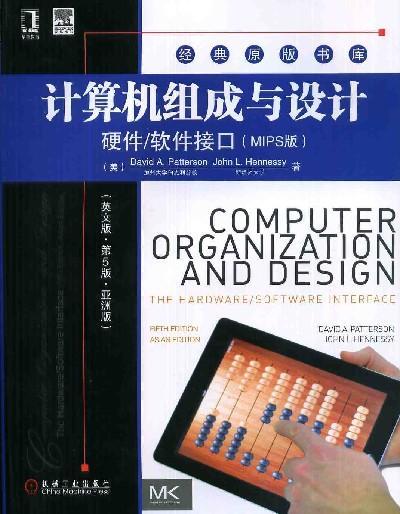计算机组成与设计:硬件/软件接口(英文版·第5版)(亚洲版)机械工业出版社 正版书籍
¥139.00
| 运费: | ¥ 0.00-15.00 |
| 库存: | 20 件 |
商品详情

| 商品基本信息 | |
| 商品名称: | 计算机组成与设计:硬件/软件接口(英文版·第5版)(亚洲版) |
| 作者: | (美)David Patterson |
| 市场价: | 139.00 |
| ISBN号: | 9787111453161 |
| 版次: | 1-1 |
| 出版日期: | 2014-02 |
| 页数: | |
| 字数: | |
| 出版社: | 机械工业出版社 |

| 目录 | |
| Preface v About the Author xiii CHAPTERS 1 Computer Abstractions and Technology 2 1.1 Introduction 3 1.2 Eight Great Ideas in Computer Architecture 11 1.3 Below Your Program 13 1.4 Under the Covers 16 1.5 Technologies for Building Processors and Memory 24 1.6 Performance 28 1.7 The Power Wall 40 1.8 The Sea Change: The Switch from Uniprocessors to Multiprocessors 43 1.9 Real Stuff: Benchmarking the Intel Core i7 46 1.10 Fallacies and Pitfalls 49 1.11 Concluding Remarks 52 1.12 Historical Perspective and Further Reading 54 1.13 Exercises 54 2 Instructions: Language of the Computer 60 2.1 Introduction 62 2.2 Operations of the Computer Hardware 63 2.3 Operands of the Computer Hardware 66 2.4 Signed and Unsigned Numbers 73 2.5 Representing Instructions in the Computer 80 2.6 Logical Operations 87 2.7 Instructions for Making Decisions 90 2.8 Supporting Procedures in Computer Hardware 96 2.9 MIPS Addressing for 32-Bit Immediates and Addresses 106 2.10 Parallelism and Instructions: Synchronization 116 2.11 Translating and Starting a Program 118 2.12 A C Sort Example to Put It All Together 126 2.13 Advanced Material: Compiling C 134 2.14 Real Stuff: ARMy7 (32-bit) Instructions 134 2.15 Real Stuff: x86 Instructions 138 2.16 Real Stuff: ARMv8 (64-bit) Instructions 147 2.17 Fallacies and Pitfalls 148 2.18 Concluding Remarks 150 2.19 Historical Perspective and Further Reading 152 2.20 Exercises 153 3 Arithmetic for Computers 164 3.1 Introduction 166 3.2 Addition and Subtraction 166 3.3 Multiplication 171 3.4 Division 177 3.5 Floating Point 184 3.6 Parallelism and Computer Arithmetic: Subword Parallelism 210 3.7 Real Stuff: Streaming SIMD Extensions and Advanced Vector Extensions in x86 212 3.8 Going Faster: Subword Parallelism and Matrix Multiply 213 3.9 Fallacies and Pitfalls 217 3.10 Concluding Remarks 220 3.11 Historical Perspective and Further Reading 224 3.12 Exercises 225 4 The Processor 230 4.1 Introduction 232 4.2 Logic Design Conventions 236 4.3 Building a Datapath 239 4.4 A Simple Implementation Scheme 247 4.5 An Overview ofPipelining 260 4.6 Pipelined Datapath and Control 274 4.7 Data Hazards: Forwarding versus Stalling 291 4.8 Control Hazards 304 4.9 Exceptions 313 4.10 Parallelism via Instructions 320 4.11 Real Stuff: The ARM Cortex-A8 and Intel Core i7 Pipelines 332 4.12 Going Faster: Instruction-Level Parallelism and Matrix Multiply 339 4.13 Advanced Topic: An Introduction to Digital Design Using a Hardware Design Language to Describe and Model a Pipeline and More Pipelining Illustrations 342 4.14 Fallacies and Pitfalls 343 4.15 CondudingRemarks 344 4.16 Historical Perspective and Further Reading 345 4.17 Exercises 345 5 Large and Fast: Exploiting Memory Hierarchy 360 5.1 Introduction 362 5.2 Memory Technologies 366 5.3 The Basics of Caches 371 5.4 Measuring and Improving Cache Performance 386 5.5 Dependable Memory Hierarchy 406 5.6 Virtual Machines 412 5.7 Virtual Memory 415 5.8 A Common Framework for Memory Hierarchy 442 5.9 Using a Finite-State Machine to Control a Simple Cache 449 5.10 Parallelism and Memory Hierarchies: Cache Coherence 454 5.11 Parallelism and Memory Hierarchy: Redundant Arrays of Inexpensive Disks 458 5.12 Advanced Material: Implementing Cache Controllers 458 5.13 Real Stuff: The ARM Cortex-A8 and Intel Core i7 Memory Hierarchies 459 5.14 Going Faster: Cache Blocking and Matrix Multiply 463 5.15 Fallacies and Pitfalls 466 5.16 GoncludingRemarks 470 5.17 Historical Perspective and Further Reading 471 5.18 Exercises 471 6 Parallel Processors from Client to Cloud 488 6.1 Introduction 490 6.2 The Difficulty of Creating Parallel Processing Programs 492 6.3 SISD, MIMD, SIMD, SPMD, and Vector 497 6.4 Hardware Multithreading 504 6.5 Multicore and Other Shared Memory Multiprocessors 507 6.6 Introduction to Graphics Processing Units 512 6.7 Clusters, Warehouse Scale Computers, and Other Message-Passing Multiprocessors 519 6.8 Introduction to Multiprocessor Network Topologies 524 6.9 Communicating to the Outside World: Cluster Networking 527 6.10 Multiprocessor Benchmarks and Performance Models 528 6.11 Real Stuff: Benchmarking Intel Core i7 versus NVIDIA Tesla GPU 538 6.12 Going Faster: Multiple Processors and Matrix Multiply 543 6.13 Fallacies and Pitfalls 546 6.14 Concluding Remarks 548 6.15 Historical Perspective and Further Reading 551 6.16 Exercises 551 APPENDICES A Assemblers, Linkers, and the SPiM Simulator A-2 A.1 Introduction A-3 A.2 Assemblers A-IO A.3 Linkers A-18 A.4 Loading A-19 A.5 Memory Usage A-20 A.6 Procedure Call Convention A-22 A.7 Exceptions and Interrupts A-33 A.8 Input and Output A-38 A.9 SPIM A-40 A.10 MIPS R2000 Assembly Language A-45 A.11 Concluding Remarks A-81 A.12 Exercises A-82 B TH-2 High Performance Computing |

| 内容简介 | |
| 帕特森、亨尼斯所著的《计算机组成与设计(硬件软件接口MIPS版英文版第5版亚洲版)》这本最畅销的计算机组成与设计的经典教材经过全面修订,关注后PCB寸代发生在计算机体系结构领域的革命性变革(从单处理器发展到多核微处理器。从串行发展到并行),并强调了新出现的移动计算和云计算。为了研讨和强调这种重大的变化,《计算机组成与设计(硬件软件接口MIPS版英文版第5版亚洲版)》更新了许多内容,重点介绍平板电脑、云体系结构以及ARM(移动计算设备)和x86(云计算)体系结构。 因为正确理解现代硬件对于实现好的性能和能效至关重要,所以本版在全书中增加了一个新的实例“GoingFaster”,以演示非常有效的优化技术。本版还新增了一个关于计算机体系结构“八大理念”的讨论。 与前几版一样,本书采用MIPS处理器来展示计算机硬件技术、汇编语言、计算机算术、流水线、存储器层次结构以及I/O等基本功能。 |
- 机械工业出版社旗舰店 (微信公众号认证)
- 扫描二维码,访问我们的微信店铺
- 随时随地的购物、客服咨询、查询订单和物流...










